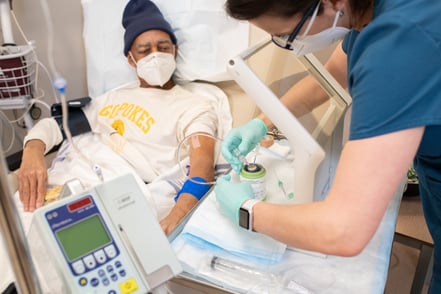Neuroendocrine Tumors: Diagnostic Challenges and Treatment Advances
5 min read

Neuroendocrine tumors – sometimes referred to as NETs – are difficult to diagnose, especially early, and complex to treat. Although rare, neuroendocrine tumor cases are rising. As a result, the challenges they pose to patients, clinicians, and healthcare systems are likely to increase. Fortunately, however, treatments and awareness are advancing. The Neuroendocrine Institute at Rocky Mountain Cancer Centers (RMCC) is on the frontlines of both.
‘Not One Disease,’ but Several
“Neuroendocrine tumors are a very complicated class of cancers,” said Dr. Eric Liu, FACS, Surgical Director of the Neuroendocrine Institute at RMCC and renowned expert in neuroendocrine tumors. “It’s not one disease, and understanding that not all neuroendocrine tumors are the same is important.”
Neuroendocrine tumors arise from neuroendocrine cells. These specialized cells of the neuroendocrine system are hybrids of sorts. They possess characteristics of nerve cells and hormone-producing endocrine cells.
Neuroendocrine tumors can develop in many parts of the body. Two of the most common types of NETs are those that form in the gastrointestinal tract, especially the rectum and small intestine, and lung. These types of tumors are sometimes called carcinoid tumors. Neuroendocrine tumors in the pancreas – also called islet cell tumors – are another major type. They’re far less common, however, than gastrointestinal and lung tumors. In some cases, it’s not clear where a neuroendocrine tumor initially developed.
Some neuroendocrine tumors produce symptoms by manufacturing and releasing hormones and other chemicals. For example, some carcinoid tumors may send serotonin into the bloodstream, causing diarrhea and other symptoms known as carcinoid syndrome. Substance-producing neuroendocrine tumors are known as functional. The majority of neuroendocrine tumors, however, are nonfunctional. These tumors release hormones (in negligible amounts) and other substances, or none at all.
Why Neuroendocrine Tumors Can Be Difficult to Diagnose
Each year, an estimated 12,000 people in the U.S. are diagnosed with a neuroendocrine tumor, according to the American Society of Clinical Oncology. Unfortunately, for many of them, the disease has spread to other parts of the body by the time clinicians detect it. That’s despite the fact that most neuroendocrine tumors grow slowly.
Why the dearth of early diagnoses? Symptoms are highly variable, depending on the type of neuroendocrine tumor, and may be nonspecific. General symptoms, such as fatigue and loss of appetite, may occur. Patients may also present with more specific symptoms, such as localized pain, vomiting, facial flushing, jaundice, a change in bowel or bladder habits, diarrhea, skin rash, hyperglycemia, or hypoglycemia. Early on, neuroendocrine tumors typically don’t cause symptoms.
“When patients have no symptoms, how would you ever know they have a neuroendocrine tumor?” Dr. Liu said. “So, often, diagnosis only happens if a clinician finds a tumor incidentally, such as during a colonoscopy or endoscopy. The most important point is that if a patient gets diagnosed, their clinician should send them to a specialist as quickly as possible.”
Dr. Liu believes the prospects of diagnosing more neuroendocrine tumors earlier are dim at best – decades of effort have met with little success – but being more proactive about ordering additional imaging or pursuing new lines of inquiry when a therapy is ineffective may help move the needle.
“For a patient with a more indolent presentation, the best thing to do is to consider some of these weird, zebra diseases, such as neuroendocrine tumors,” Dr. Liu said. “If, for example, a patient has persistent diarrhea for a long time, something odd could be happening, so maybe order a CT scan to investigate further.”
Wide-Ranging Treatment Options for Neuroendocrine Tumors
 Curing patients with neuroendocrine tumors isn’t always possible, but clinicians who specialize in these cancers have an expanding pool of options to help increase longevity and improve quality of life. At the Neuroendocrine Institute at RMCC, a multidisciplinary group of clinicians with deep expertise in neuroendocrine tumors collaborate to design and deliver individualized treatment plans.
Curing patients with neuroendocrine tumors isn’t always possible, but clinicians who specialize in these cancers have an expanding pool of options to help increase longevity and improve quality of life. At the Neuroendocrine Institute at RMCC, a multidisciplinary group of clinicians with deep expertise in neuroendocrine tumors collaborate to design and deliver individualized treatment plans.
“We can offer surgery, different types of interventional radiology, medications, chemotherapies, and injectable radiation therapy, just to name a few,” Dr. Liu said. “What makes neuroendocrine tumors so difficult is choosing the right therapy. With most cancers, you have steps 1, 2, 3, and 4, and that’s it. With neuroendocrine tumors, depending on the therapies you choose and how you sequence them, you can improve patients’ symptoms, which makes a big difference in the quality and length of life.”
Carcinoid tumors and other neuroendocrine malignancies don’t have a best, one-size-fits-all treatment, largely due to their variability. However, Dr. Liu typically recommends considering surgery to remove the tumor, followed by what he calls tailoring treatment to the nature of the cancer based on location and grade, among other factors. Treatment options range from a conservative approach, such as active surveillance, to systemic treatments, such as hormone therapy, chemotherapy, and targeted therapies, to localized therapies, which include surgery, radiation therapy, and, for disease that spreads to the liver, embolization.
“These tumors are highly individualized,” Dr. Liu said. “The data points we have to consider include: How is the patient feeling? What are the symptoms? Is the patient having pain? Is there a way to improve their quality of life? What tools, then, do I have to effectively treat them?”
Leveraging the Power of Theranostics
 One of the newest tools in Dr. Liu’s armamentarium exists in the realm of theranostics. Clinicians use a specialized nuclear medicine test to identify candidates for an injectable radiotherapy. Dr. Liu helped to pioneer the imaging technique, the DOTATATE PET/CT scan, which can determine whether a patient is likely to respond to Lutathera, a radioactive agent that received FDA approval in 2018.
One of the newest tools in Dr. Liu’s armamentarium exists in the realm of theranostics. Clinicians use a specialized nuclear medicine test to identify candidates for an injectable radiotherapy. Dr. Liu helped to pioneer the imaging technique, the DOTATATE PET/CT scan, which can determine whether a patient is likely to respond to Lutathera, a radioactive agent that received FDA approval in 2018.
“When we developed the DOTATATE PET/CT, you could suddenly see everything, like going from a muddy pair of glasses to 4K TV,” Dr. Liu said. “Now, with the advent of Lutathera, we can do something with that information. If the patient has a positive signal on their DOTATATE PET/CT, they’re a good candidate for the injectable radiotherapy. A poor signal indicates there’s a low possibility of improvement with Lutathera. If we give a patient chemotherapy, we don’t know whether it’s going to work or not. We administer it and hope it works. At least with the DOTATATE PET/CT, we have a sense of who’s going to have a fighting chance with Lutathera.”
Certain patients with gastroenteropancreatic neuroendocrine tumors may be eligible for Lutathera. The radioactive medication binds to tumors’ somatostatin receptors.
“Lutathera treats every tumor in the body,” Dr. Liu said. “All of the tumors attract and absorb the radiation, and they receive treatment from the inside out for weeks. It’s a targeted therapy. We inject the medication, and it knows right where it needs to go.”
Lutathera may arrest the cancer’s growth or cause it to shrink. Hundreds of patients have received Lutathera at RMCC, where we administer the treatment in a dedicated theranostics suite at our Denver – Midtown location.
NETs Gains: A Hopeful Future for Neuroendocrine Tumors
Cases of neuroendocrine tumors are rising around the globe. The reasons for this increase are unclear, although advances in diagnostic imaging and greater awareness may contribute. Despite the increasing case numbers, Dr. Liu sees plenty of reasons for hope.
“The number of neuroendocrine tumor cases continues to rise, so it’s going to be a bigger problem for people over the next generation,” Dr. Liu said. “What’s exciting for me is more tools are being developed. We’re playing a part in that process by following patients, improving scans and therapies, and tailoring therapies to individuals.”
Have a patient who’s been diagnosed with a neuroendocrine tumor? Refer him or her to the Neuroendocrine Institute at RMCC for evaluation and treatment from one of the country’s premier neuroendocrine tumor programs.